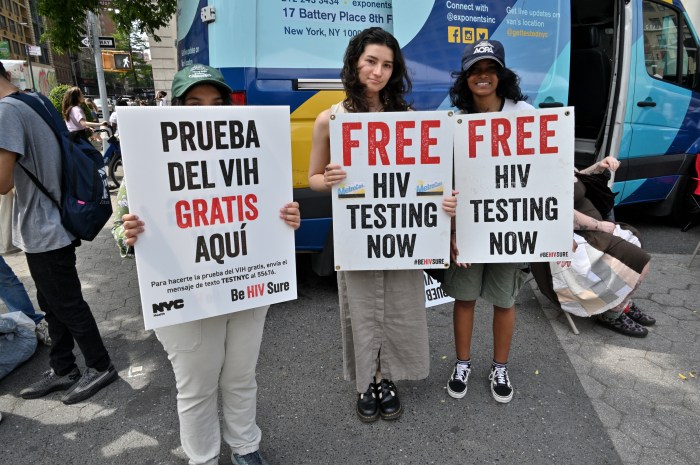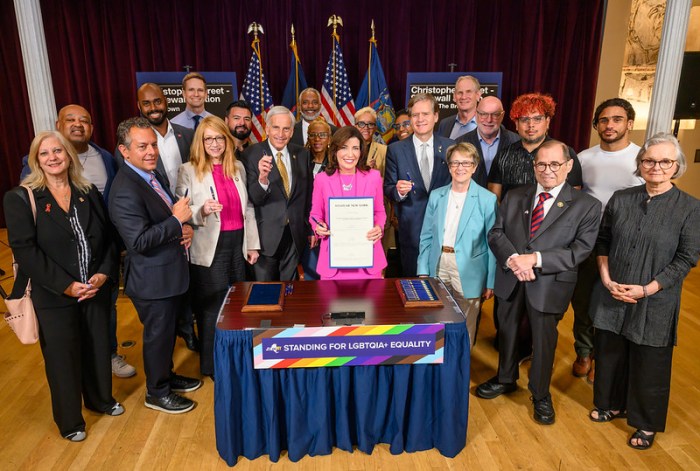While the city’s Department of Health and Mental Hygiene (DOHMH) has been touting HIV testing and treatment for those who test positive as an effective prevention approach, the HIV testing the city has done at DOHMH clinics and paid for at private groups declined by more than 18 percent from the 2011 fiscal year to the 2012 fiscal year.
“The 18.2 percent decline in HIV tests from Fiscal 2011 to Fiscal 2012 is due to incomplete reporting from contracted providers resulting from a transition to new contracts and data reporting system and to a reduction of TB and STD clinic services that offered HIV testing services,” the department wrote in the 2012 Mayor’s Management Report, which was released on September 19.
Like health agencies and AIDS groups across the country, DOHMH has adopted the strategy that treatment and more HIV testing, along with condoms and other safe sex practices, can reduce new HIV infections. The theory is that people who learn they are positive will change their behavior to avoid infecting others and, with treatment, they will be less infectious so if they do have unsafe sex, they will be less likely to infect others.
Government funders, including DOHMH, are increasingly spending their cash on HIV testing and treating those who are positive.
Earlier this year, Gay Men of African Descent, an AIDS group that serves gay African-American men, lost a significant portion of a city contract and the use of a DOHMH testing van because the health department said GMAD was not identifying enough newly infected men in its HIV testing efforts. GMAD is struggling financially.
The city either conducted or paid contractors for 201,624 HIV tests in the 2008 fiscal year. That climbed to 291,551 tests in the 2011 fiscal year and then fell to 238,347 in the 2012 fiscal year. The target for the 2012 fiscal year was 250,000 HIV tests. That same target is in place for the current fiscal year, which suggests that the reduced testing may continue.
According to DOHMH data presented at the International AIDS conference, held in Washington, DC, in July, rapid HIV testing has allowed the city to test more people and identify more previously unidentified cases.
In 2006, the city conducted 28,298 rapid HIV tests. That rose to 166,141 tests in 2010. The number of newly diagnosed cases went from 245 in 2006 to 594 in 2010, so increasing HIV testing by a factor of roughly six more than doubled the number of newly diagnosed cases found. The city is also testing a lot of people who were previously diagnosed. That number went from 166 in 2006 to 576 in 2010. About 80 percent of the HIV-positive people in that study who were newly or previously diagnosed were linked to care within 90 days.
Other city data show that more HIV testing has led to reductions in the number of people who are diagnosed with AIDS within 30 days of first testing HIV-positive. It can take eight to 10 years to go from HIV positive to an AIDS diagnosis, so these people were likely infected for years before getting tested and receiving their diagnosis.
While San Francisco’s health department has shown data it says proves the effectiveness of the testing and treating strategy, New York City has yet to produce such data, though treatment obviously keeps people with HIV healthier for longer.
A DOHMH study presented in March at the Conference on Retroviruses and Opportunistic Infections in Seattle reported that while community viral load, or the average amount of HIV in people’s blood, showed statistically significant declines in the city and among men who have sex with men from 2005 to 2009, the declines in the new infection rates that occurred in that time were not statistically significant.
A recent city study challenges one component of the testing and treating strategy — that men who have sex with men will change their unsafe sexual behavior after they learn their HIV status.
In 2011, the city interviewed 510 gay and bisexual men at bars, parks, gyms, and other venues as part of the National HIV Behavioral Surveillance Study. Out of the 510 men, 475 were tested for HIV and 19.2 percent were positive, or roughly one out of five.
Only seven percent of the white men who tested positive were unaware of their status, but that figure was 45 percent for the African-American men, 46 percent for the Latino men, and 50 percent for the men who identified as other. The white men, regardless of their HIV status, reported as much unprotected anal sex as the Latino men and more than the African-American men.
Fifty-one percent of the white men said they had unprotected anal sex in the prior year as did 51 percent of the other men. Thirty-two percent of the white men and 31 percent of the other men reported having had unprotected anal sex at their last sexual encounter.
Fifty-eight percent of the Latino men said they had such sex in the prior year and 37 percent of the Latino men said they had unprotected anal sex during their last sexual encounter.
Among the African-American men, 45 percent reported unprotected anal sex in the year before the interview and 23 percent they had such sex during their last sexual encounter.
The city health department did not respond to a request for comment on the data in the 2012 Mayor’s Management Report.



































